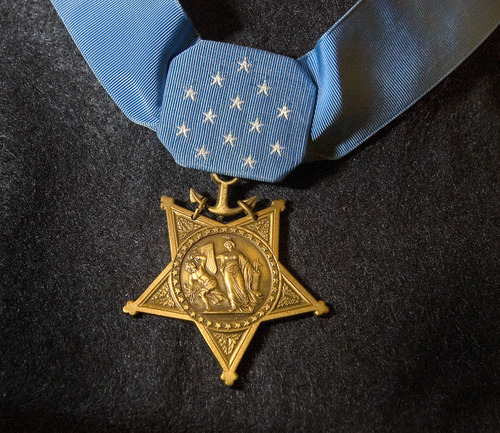This is an archived article that was published on sltrib.com in 2011, and information in the article may be outdated. It is provided only for personal research purposes and may not be reprinted.
Although no record exists of Peter Tomich ever having set foot in Utah, he is regarded as one of the state's most distinguished sons — by way of adoption.
Born in Europe more than a century ago, Tomich spent his life roaming the world. On Wednesday, he will have died 70 years ago. His remains, along with those of more than 50 of his shipmates, rest inside the rusting hulk of the battleship USS Utah in Pearl Harbor
The odyssey that would bring Tomich "home" to Utah began in 1893. Born in a small village in the Austro-Hungarian Empire, Tomich immigrated illegally to the United States in 1912. He served in the U.S. Army during World War I, and became a citizen in 1918. Following the war, he reenlisted in the U.S. Navy and found a home.
An orphan, Tomich's only address during the following years was "U.S. Navy." He rose through the enlisted ranks, eventually reaching Chief Petty Officer. He was chief water tender aboard the USS Utah on that fateful Sunday morning.
Shortly after 8 a.m., as the colors were being raised, two Japanese torpedoes struck the Utah. Within minutes, the ship began to list heavily. The order was passed to abandon ship.
Commissioned in 1909, the USS Utah was an aging Florida-class battleship at Pearl Harbor. She saw service protecting American interests during the Mexican Revolution and later in World War I. By 1941, however, she had been decommissioned and was serving as a target ship for bombing and gunnery practice.
Tomich was preparing to leave the Utah with the rest of the crew when he saw the ship was about to roll over in the water. Fearing that water would reach the boilers and cause a devastating explosion, Tomich immediately returned to the engine room to shut them down.
Tomich remained in the boiler room to ensure that everyone had evacuated safely. He put out the boiler fires and was still at his post when the ship's mooring lines snapped and it rolled over and sank.
In the final moments, the veteran sailor had to know what was happening, that both he and his U.S. Navy home were doomed. Nevertheless, he remained behind and died along with 57 other members of the crew.
In March 1942, Congress posthumously awarded Tomich the Medal of Honor. The medal remained in the hands of the military while it searched for Tomich's family.
Tomich's service record listed a cousin John Tomich living in Los Angeles but a search for him turned up nothing. The search continued for several years, but failed to produce results. Unbeknownst to the military, John Tomich had returned to Austria in 1920.
Five years later, with no family members available, the military turned to the namesake of Tomich's Navy home: the state of Utah.
On May 25, 1947, Utah Gov. Herbert B. Maws formally adopted Tomich as his "son," making him an honorary citizen of Utah. In a ceremony at the Capitol, the U.S. Navy presented Tomich's medal to Maws.
The medal was displayed for years in a bronze and glass case at the Capitol. In 1951, it was turned over to the Utah Historical Society.
In 1963, Tomich's original medal was returned to the military for display in the National Museum of the U.S. Navy in Washington, D.C. A replica medal was given to the state of Utah.
Utah did not forget Tomich or the ship where he lay. In 1972, after a prolonged fight by supporters to secure the final resting place of Tomich and his shipmates, Utah Sen. Frank Moss dedicated a memorial built near the USS Utah.
The saga of Utah's adopted son wasn't over. A retired military officer eventually took up the Tomich case and studied the family genealogy, eventually tracking the family line back to the Croatian village of Prolog.
On May 18, 2006, in a ceremony aboard the aircraft carrier USS Enterprise, retired Croatian Army Lt. Col. Srecko Herceg Tonic received the U.S. military's highest award on behalf of the Tomich (Tonic) family.
Sixty-four years after Peter Tomich died for his new country, the spirit of Utah's adopted son had finally found its way back home.
Robert Kirby can be reached at rkirby@sltrib.com or facebook.com/notpatbagley. —
More about Peter Tomich and the USS Utah
In 1942, nearly a year after Peter Tomich's death, the destroyer escort USS Tomich was launched at Houston. The ship saw active service primarily in the Atlantic and was decommissioned in 1946.
When the USS Utah was decommissioned in 1931, the silver service from the captain's wardroom was given to the Utah Historical Society. Parts of the service were stolen during a burglary in 1974 and never recovered.
The 48-star flag reportedly rescued from the USS Utah before it sank was given to the Utah Historical Society on Dec. 7, 1973. The ship's bell is on display at the University of Utah.
Tomich is not the only Congressional Medal of Honor winner associated with the USS Utah. Seven other members of her crew were awarded the medal for heroism at Veracruz, Mexico, in 1914.









